Our Verdict
Arguably the best budget GPU right now, though the 4GB VRAM could prove limiting in upcoming games.
For
- Great overall value
- Much faster than the 1650
- Includes Turing NVENC
Against
- Only 4GB VRAM
- Requires 6-pin power
PC Gamer's got your back
Today marks the official launch of Nvidia's latest graphics card, the GeForce GTX 1650 Super. Like the other Super branded GPUs launched this year—the RTX 2080 Super, RTX 2070 Super, RTX 2060 Super, and GTX 1660 Super—the 1650 Super represents modest improvements to an existing part. In this case, the specific part that's being used is the TU116. If you're up to snuff on Nvidia's GPUs, that's actually the step up from the bottom Turing TU117 GPU used in the GTX 1650.
Why the change? Simple: the TU117 lacks a few of the extra features found in its big brother. Specifically, it uses the older Pascal-era NVENC block. It may also lack GDDR6 support, though Nvidia hasn't made any clear comments in that regard. Either way, TU116 has both the new and improved Turing NVENC that promises better quality than x264 Fast encoding via the CPU with a minimal hit to framerates, as well as GDDR6 support. That should be useful for any budding streamers. It's also possible that Nvidia is getting enough TU116 chips that aren't fully functional that it just makes good sense to come out with the 1650 Super using TU116.
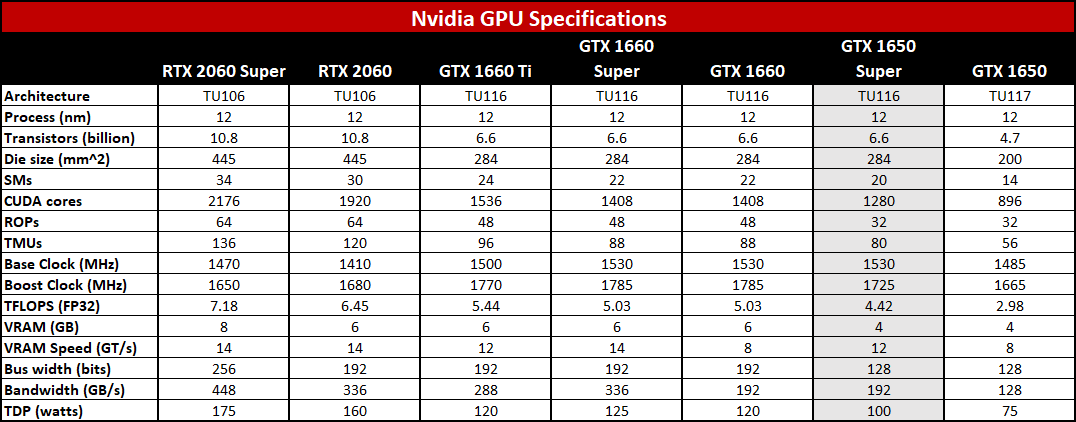
In terms of core specs, the GTX 1650 Super is a healthy jump in performance from the existing GTX 1650. It has 42 percent more GPU cores, and while it sticks with a 128-bit memory interface, the move to 12Gbps GDDR6 means it has 50 percent more bandwidth than the 1650. Perhaps even more interesting, it ends up with the same bandwidth as the vanilla 1660, though with fewer cores and lower clocks.
There is one potential concern with the 1650 Super: VRAM, more specifically, the 4GB of GDDR6. It may have the same total bandwidth as the 1660, but with 2GB less memory there are definitely going to be situations where performance will be lower. How much lower depends on the game and settings, and I've seen quite a few new games during the past year where only having a 4GB GPU is going to be limiting. Things won't get any better going forward, either, with the next generation of consoles arriving in 2020.
Nvidia hasn't officially dropped prices on the non-Super 1650 and 1660 cards, but my understanding is that they'll both continue to coexist alongside their Super siblings. With an official launch price starting at $159 for the 1650 Super, the regular GTX 1650 is likely to drop in price—and it sort of already has, with at least one EVGA GTX 1650 card available for $135 (after rebate). The thing is, with Black Friday deals effectively having started, it's not clear what the official pricing is. But if you were previously thinking about a budget GPU like the 1650, spending $10 more for the 1650 Super should be a no-brainer.
What's the real-world gaming performance look like for the GTX 1650 Super? With a launch day driver now in hand, I've run my usual benchmark suite. It's the same 441.20 drivers that Nvidia released for Jedi Fallen Order, but with the appropriate configuration files to allow the drivers to work on the 1650 Super. I've got MSI's GeForce GTX 1650 Super Gaming X, so let's see how it performs.
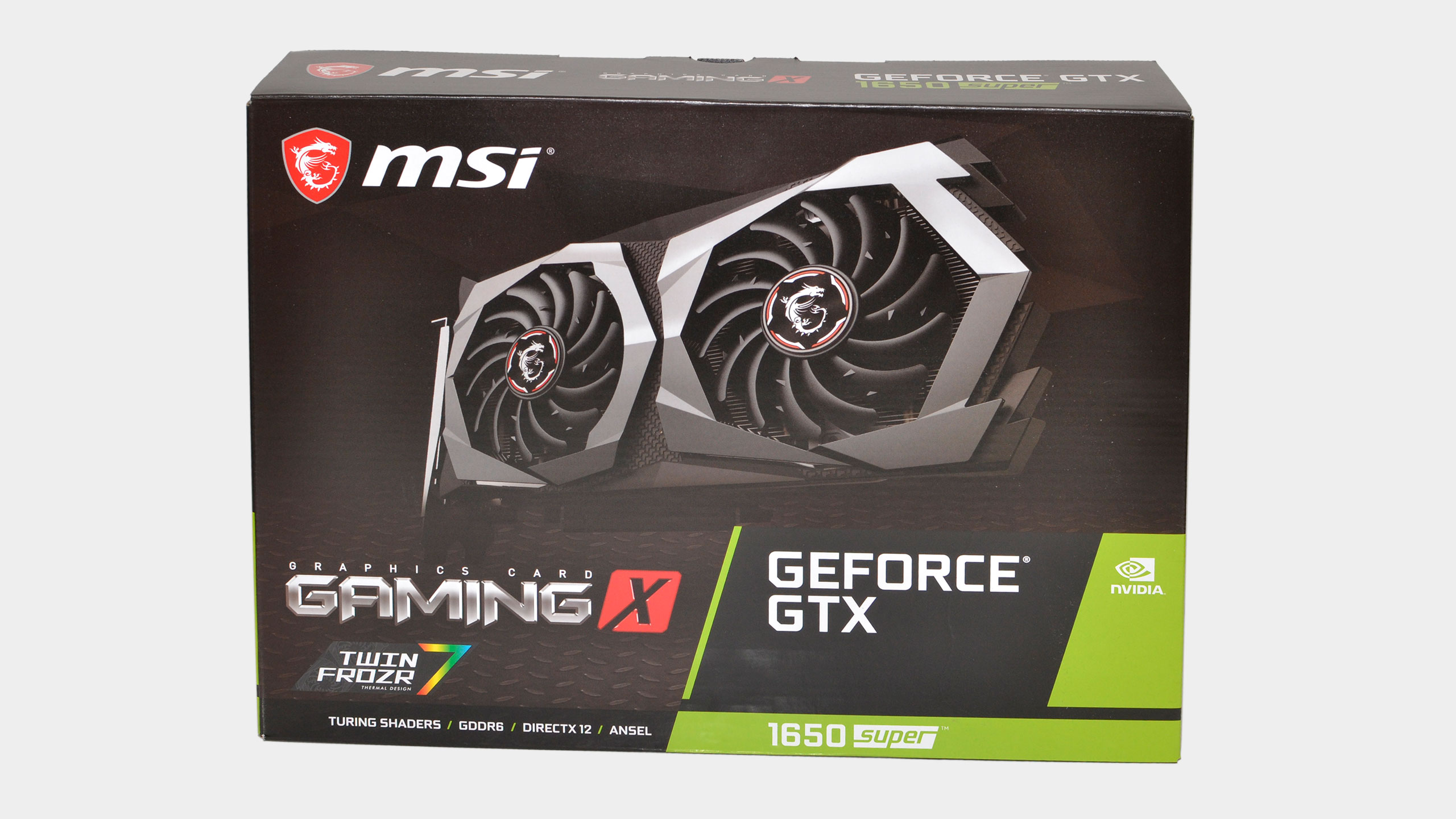
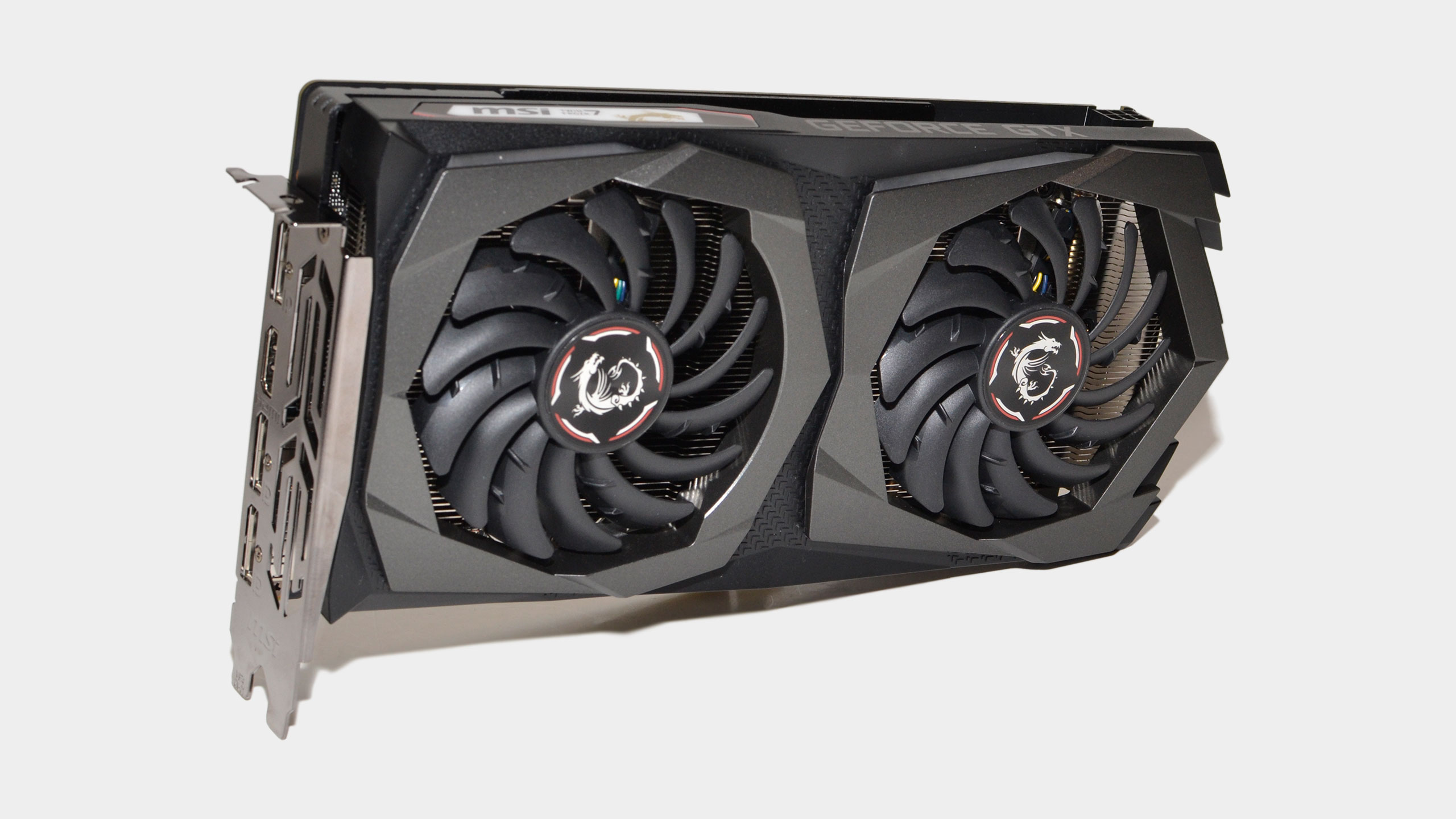
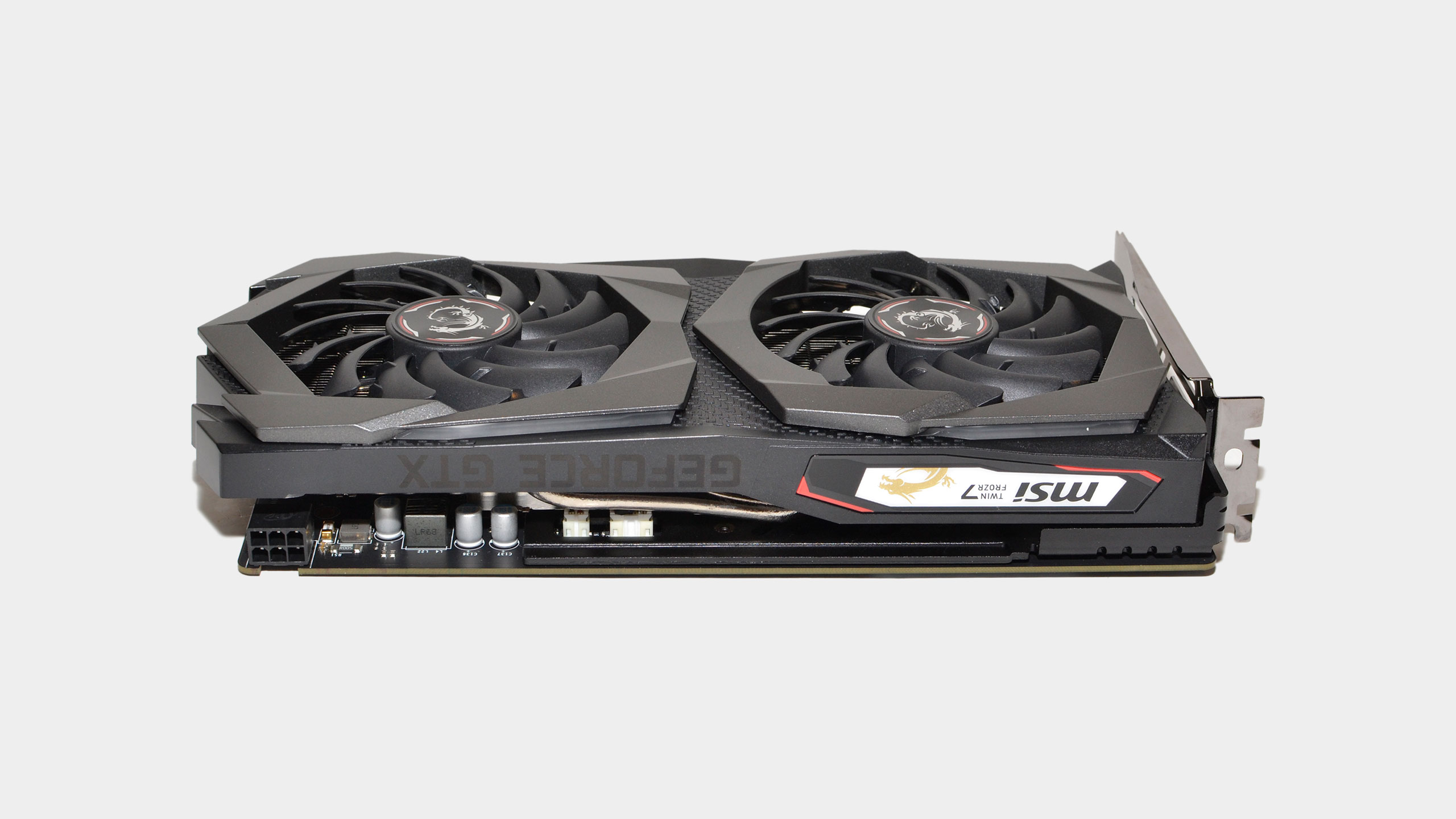
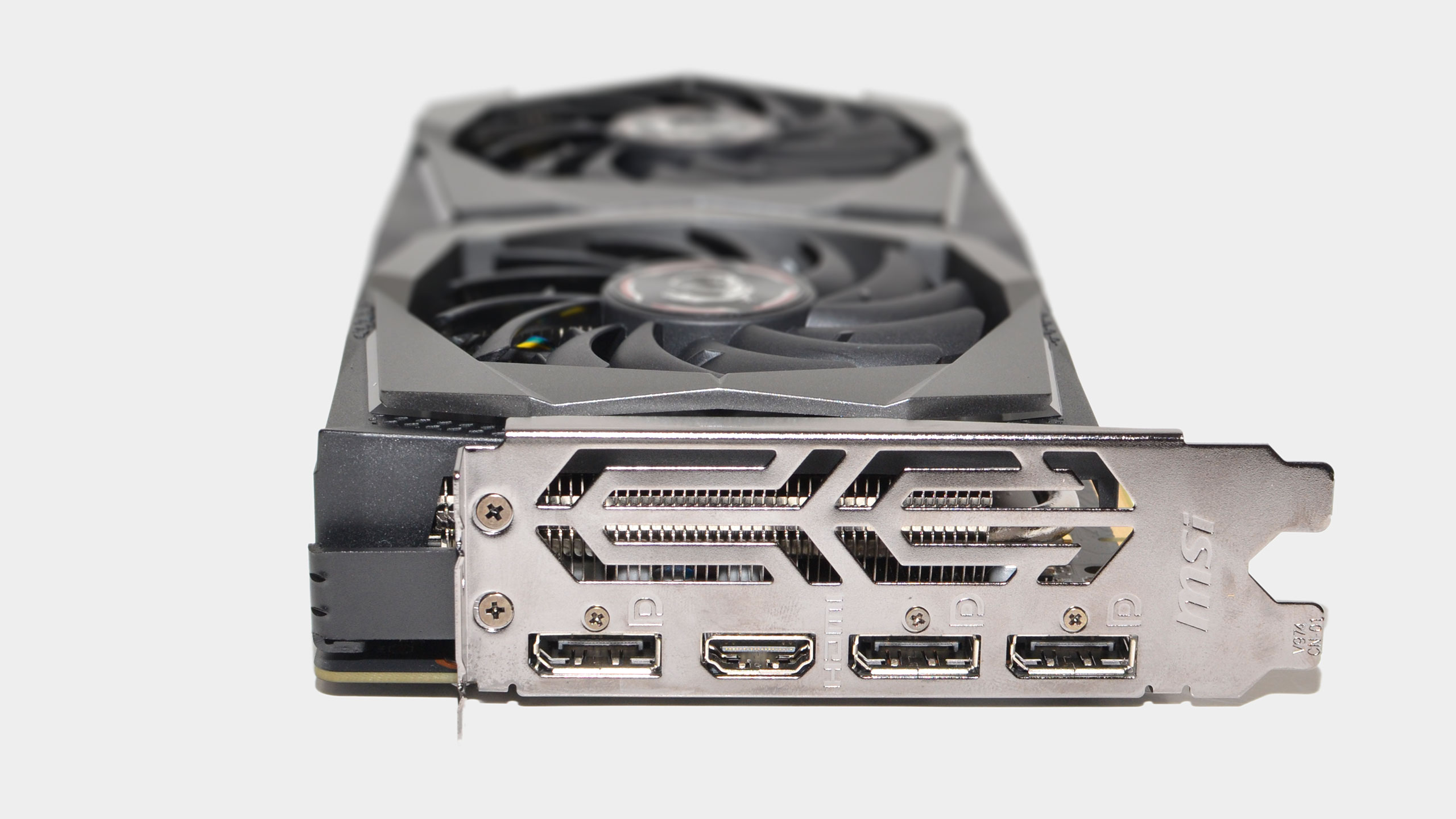
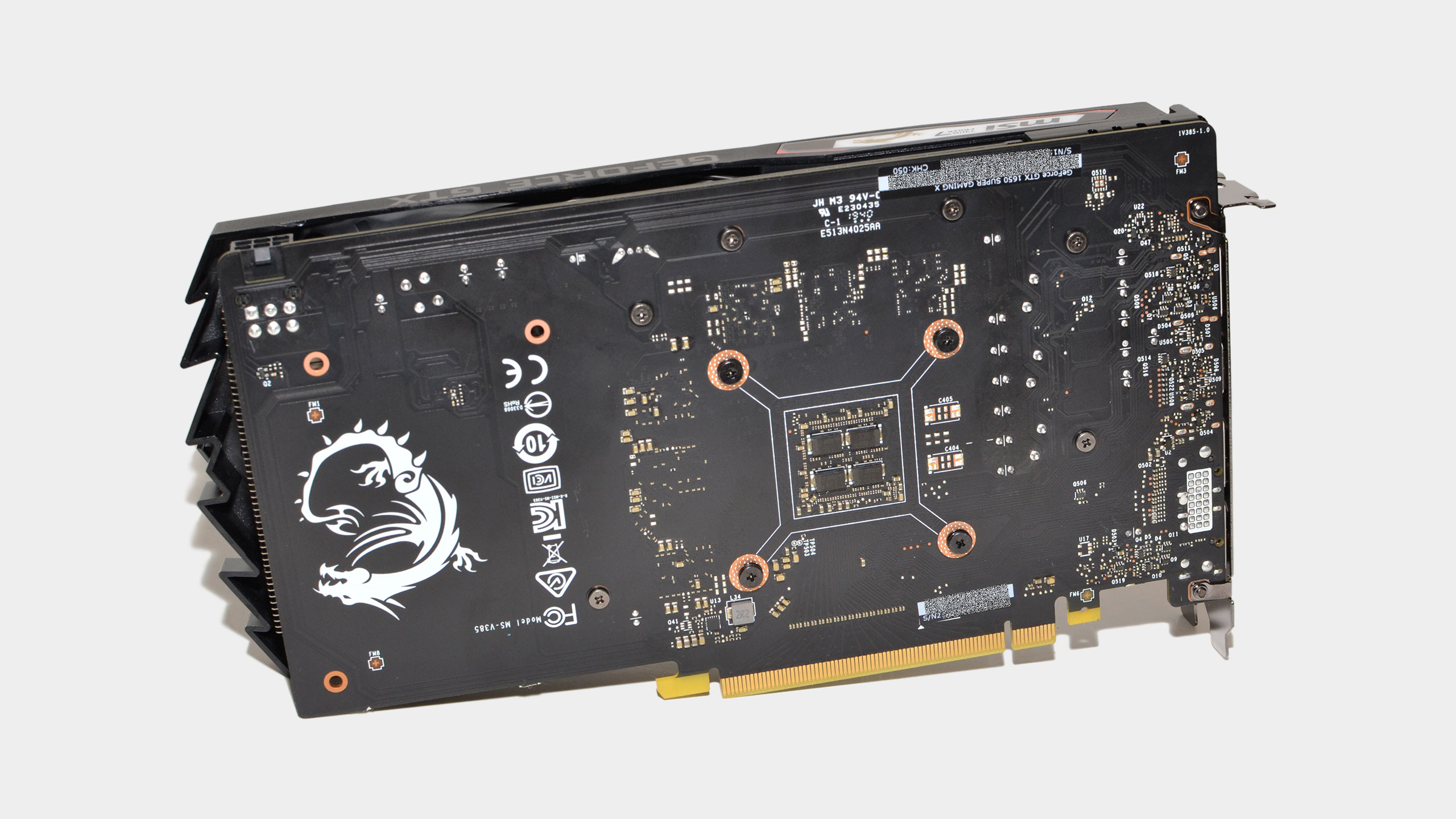
Meet the MSI GTX 1650 Super, plus overclocking
Visually, MSI's new GTX 1650 Super card looks nearly identical to the GTX 1650 Gaming X, but there are a few minor tweaks. Both cards require a 6-pin PCIe power connector, but while the PCB is the same size, the 1650 Super layout is slightly different—it's using the same board as the 1660 cards, which makes sense as both use the same TU116 GPU. The 1650 Super also has an extra DisplayPort output, compared to MSI's vanilla 1650 card.
Like many custom cards, MSI's 1650 Super Gaming X comes with a factory overclock. In this case, it's not much to speak of: the Boost clock is 1755MHz, compared to the reference 1725MHz. That's a relatively negligible overclock, and just about any other 1650 Super should be able to match it. That doesn't mean the card couldn't go further, however.
The VRAM in particular is capable of hitting at least 15Gbps, which is the default maximum in MSI Afterburner. Like most Turing GPUs, the real-world clockspeed of the GPU is typically much higher than the listed Boost clock. I saw clockspeeds of 1850-1900MHz at 'stock' and was able to add another 100MHz via overclocking. With the memory and core overclock, that's good for an additional 10-15 percent performance, depending on the game and settings you run. That's assuming everything stays stable, of course.
Something else to note is that the GTX 1650 Super is a 100W TDP card, which means it absolutely requires a 6-pin power connector. If you have a PC that doesn't have any PCIe power cables available (which is the case for some budget pre-built PCs), you'll need to stick with the vanilla 1650.

GeForce GTX 1650 Super gaming performance
Let's hit the benchmarks, with my usual test PC running an overclocked i7-8700K. That's nominally to eliminate any other bottlenecks, though in this case the 1650 Super is definitely the limiting factor.
I've got my usual collection of games, 11 right now, including a few newer titles. I've tested at 1080p medium and 1080p ultra settings (except where noted), as well as 1440p ultra. That's not because 1440p is really the point of a card like the 1650 Super, but more to see what happens as resolution and VRAM requirements increase.
I'm including other GPUs priced at around $300 down to the budget cards, as well as a couple of representatives of the old guard. The GTX 970 and R9 390 were both great cards several years back. That level of performance is now generally available in a budget card like the 1650 Super.

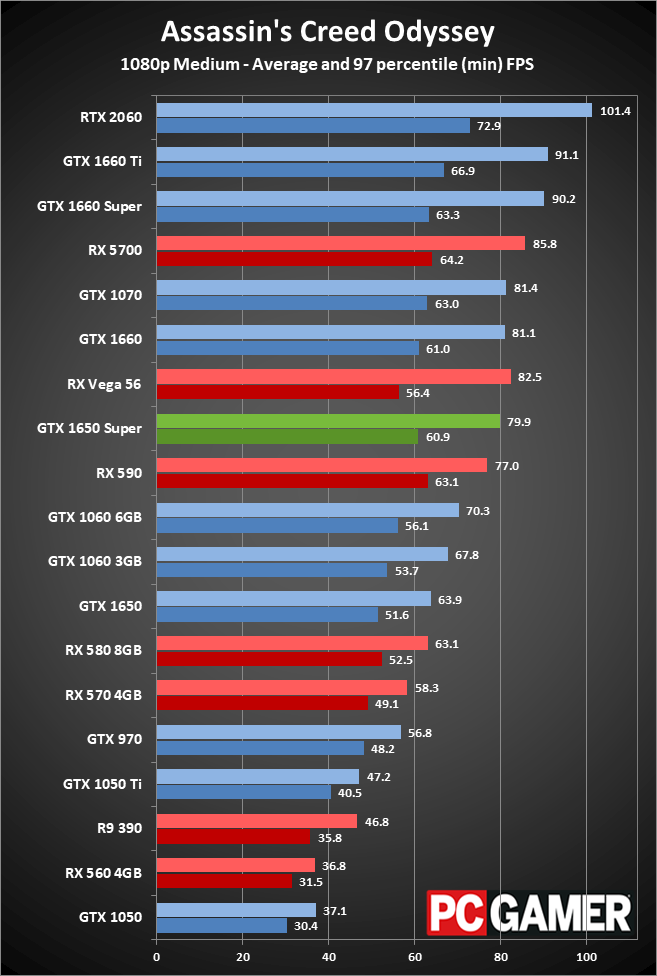
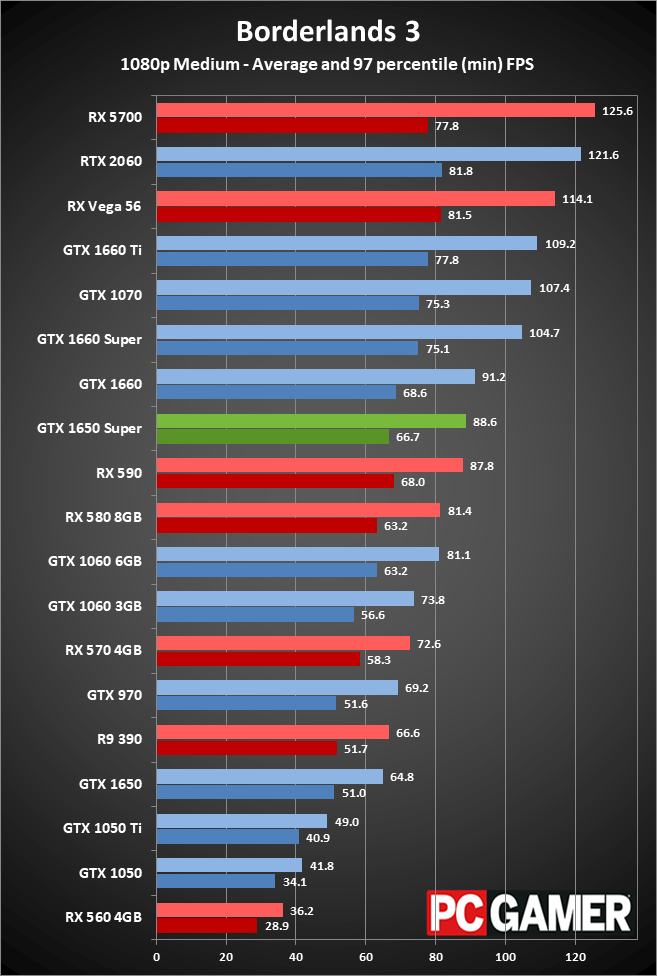
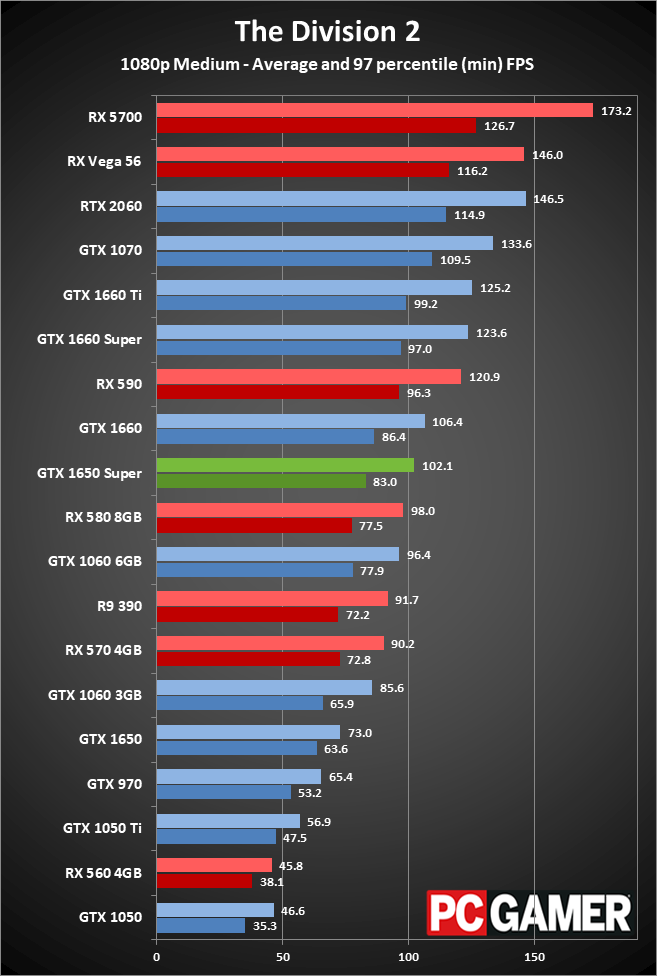

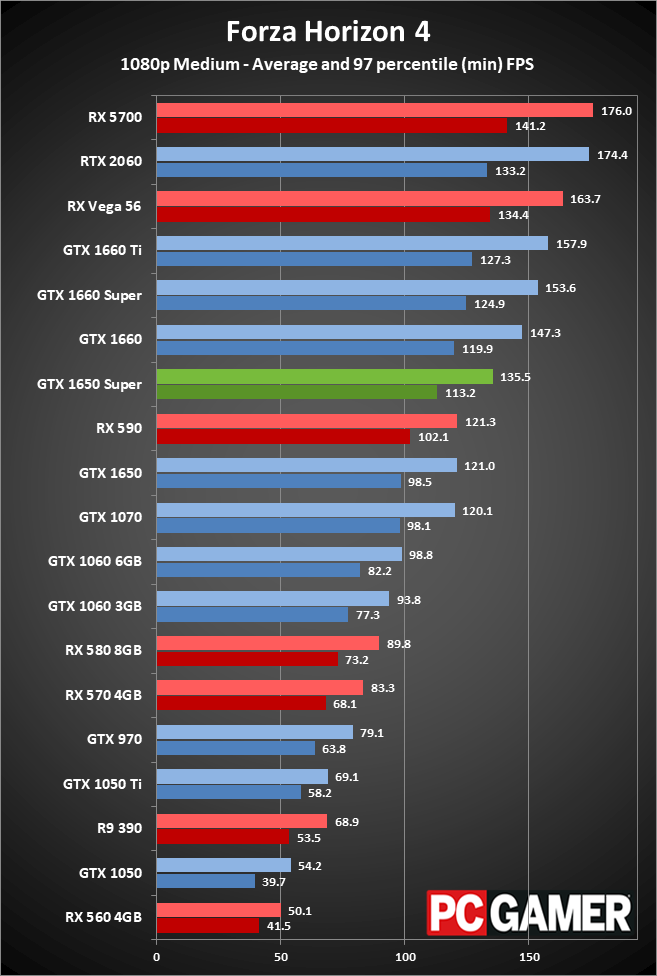
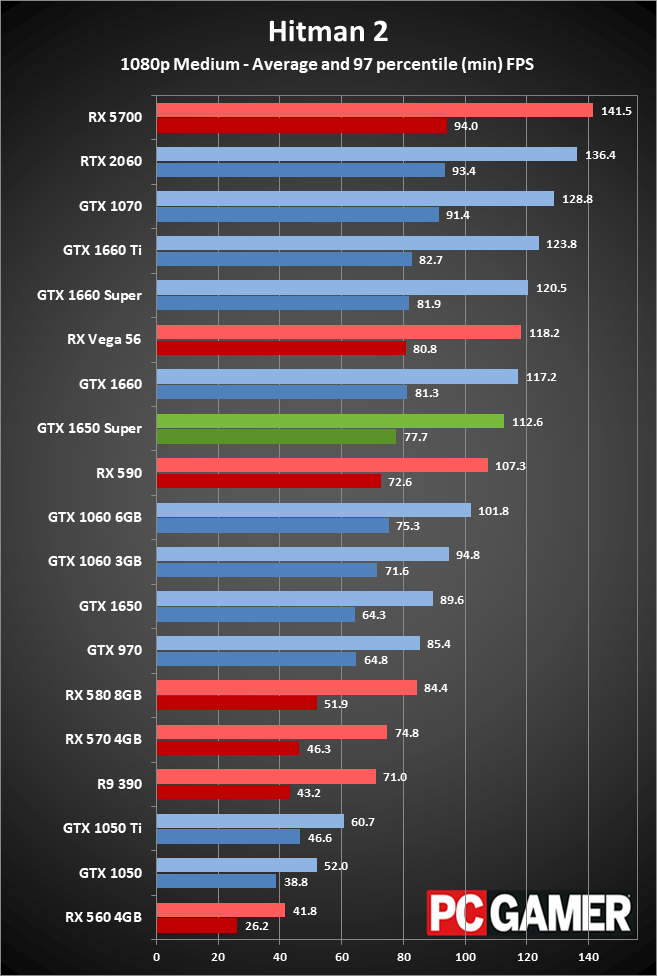
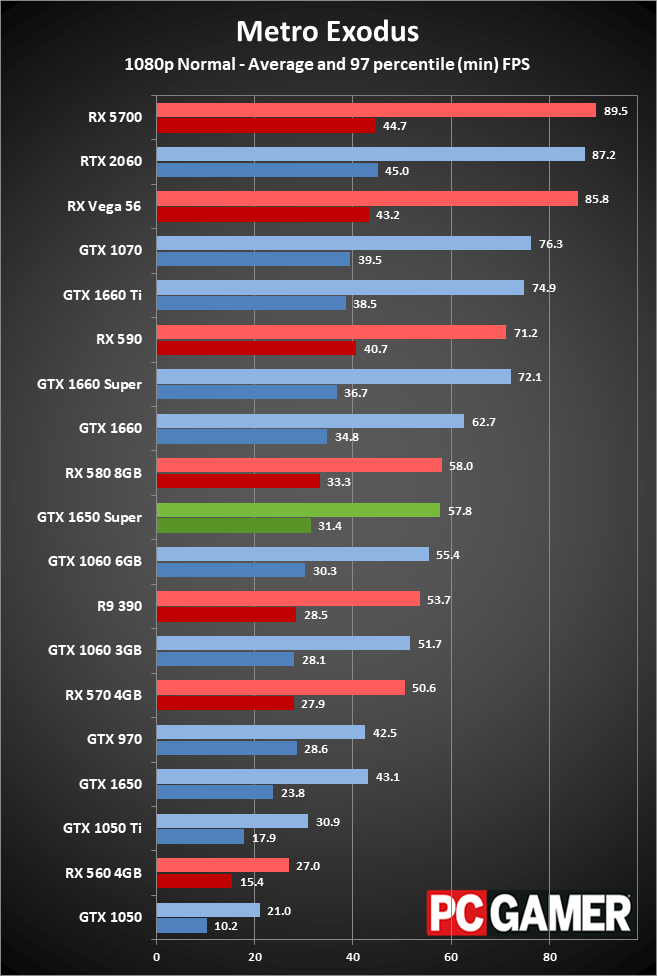
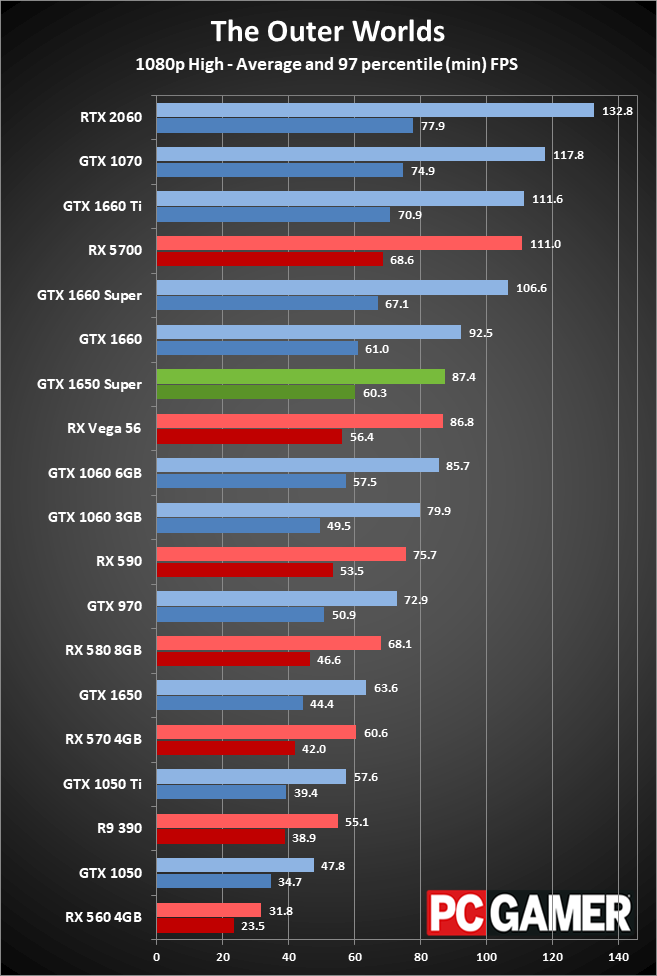
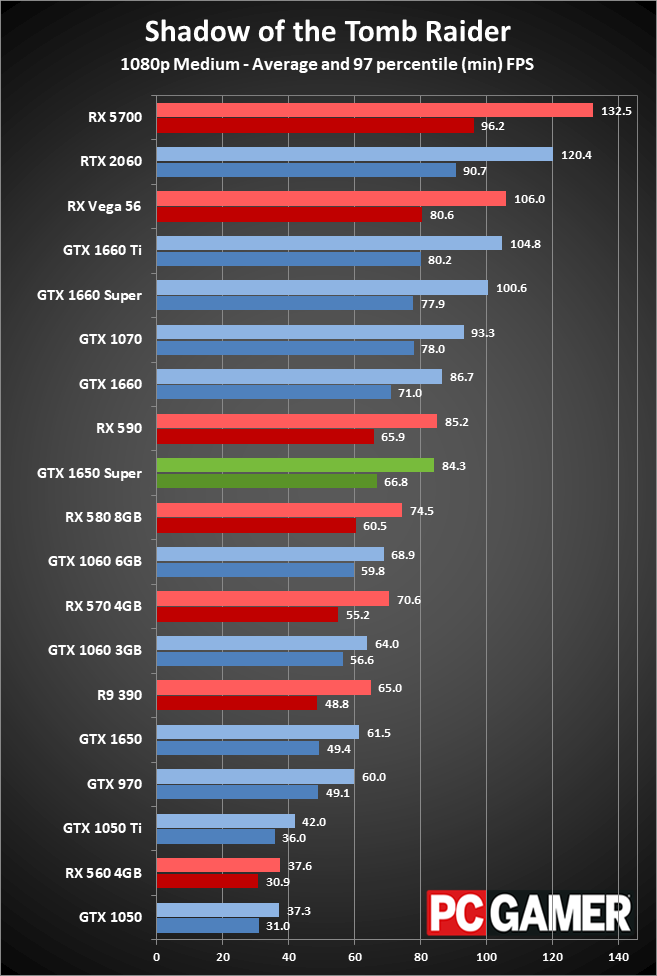

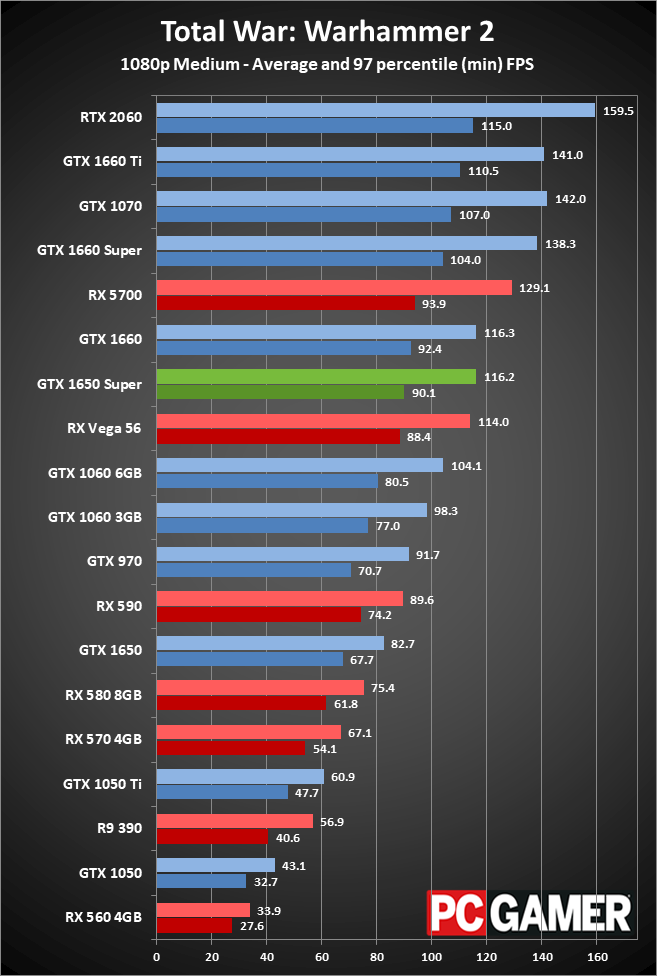
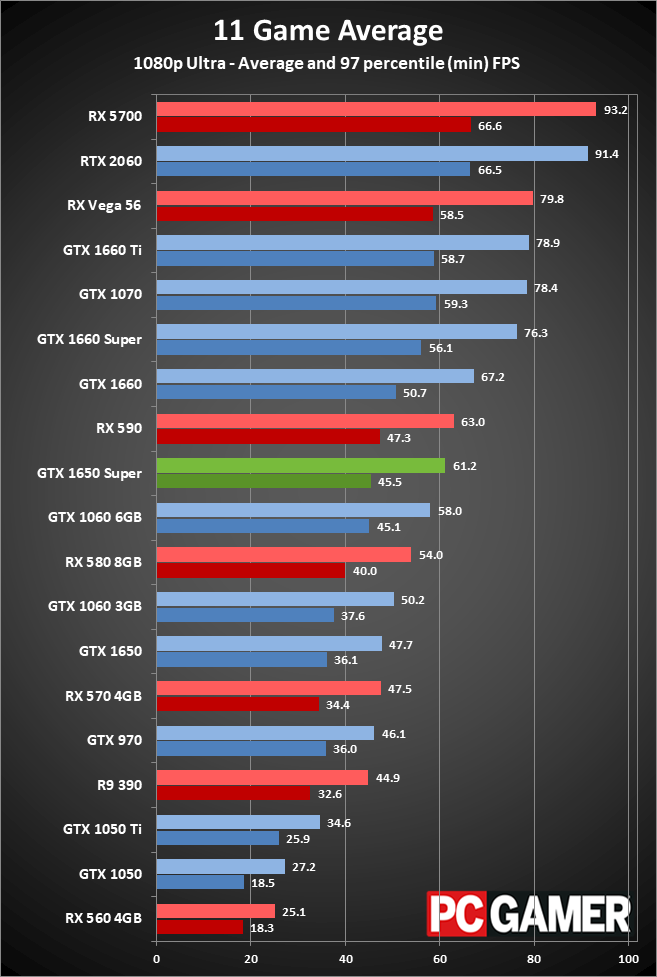
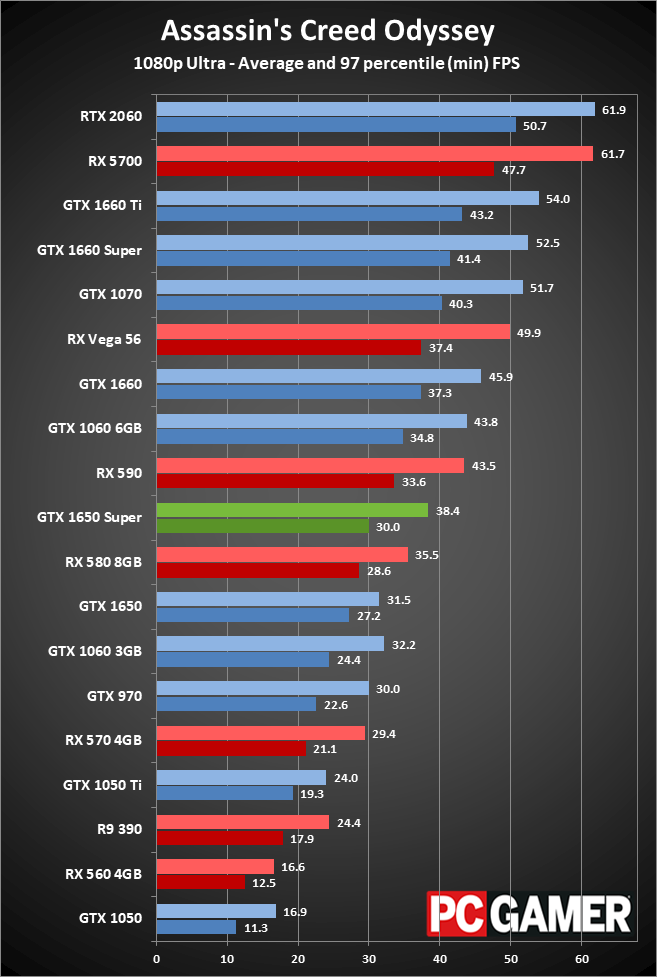
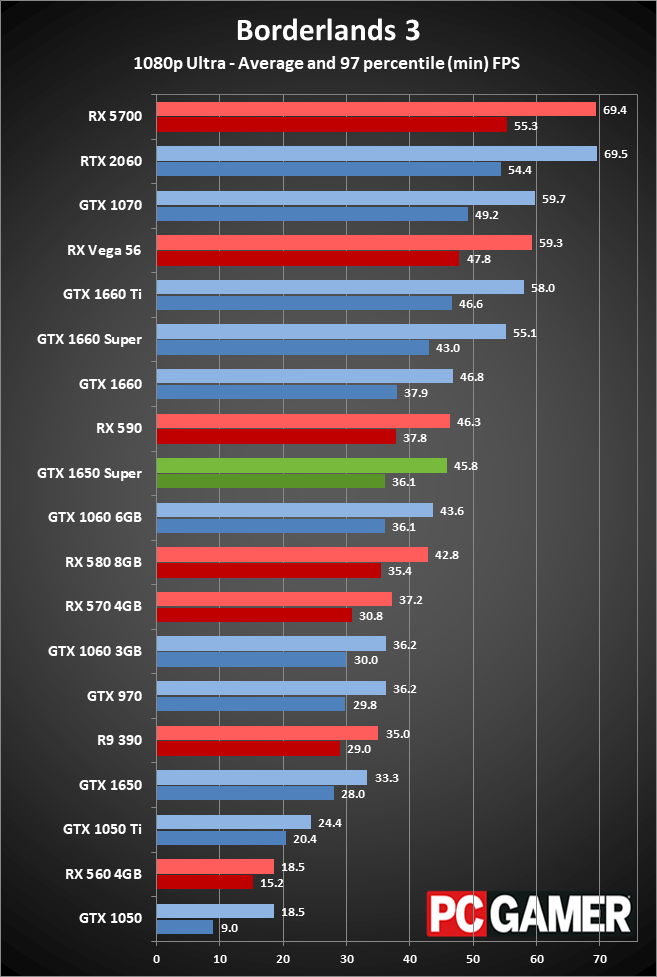
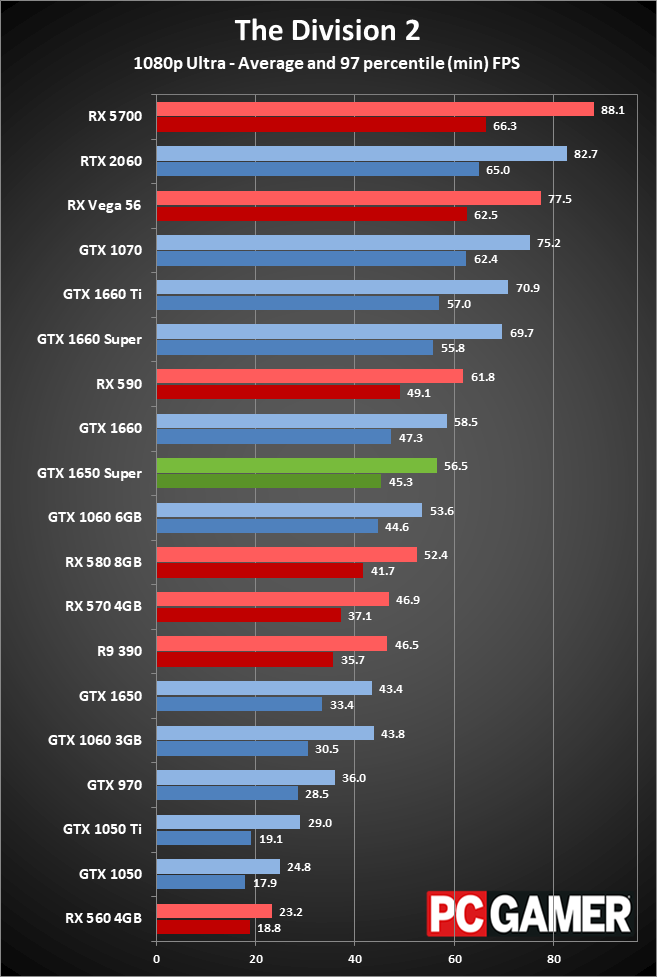
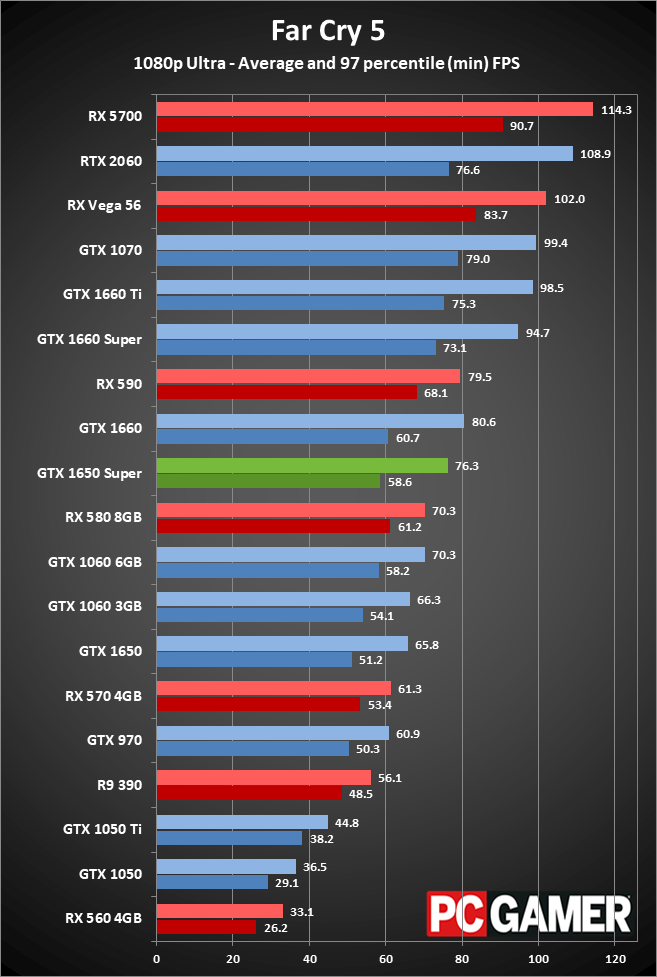
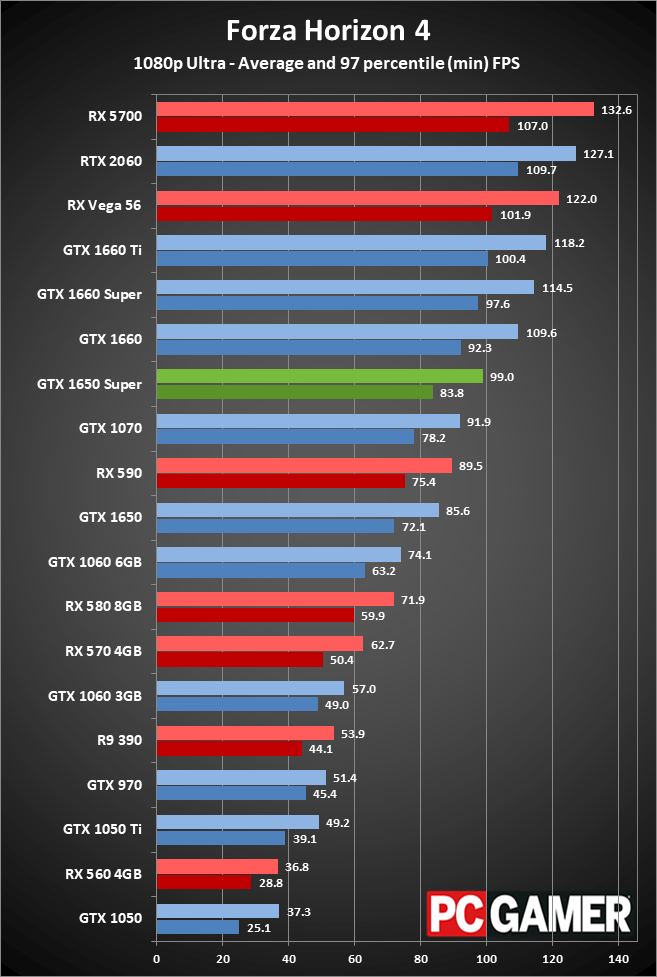
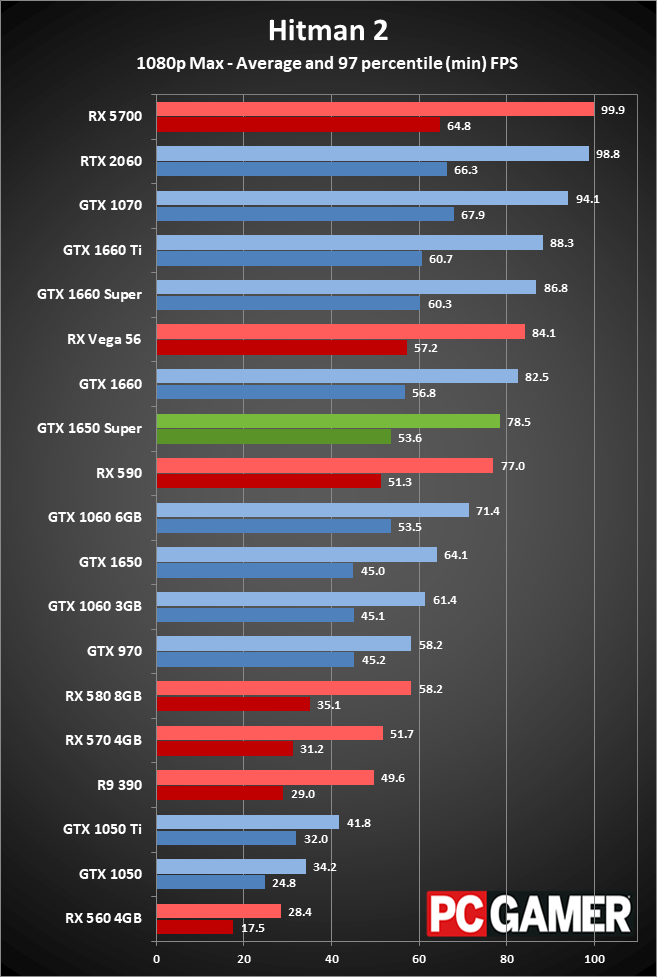
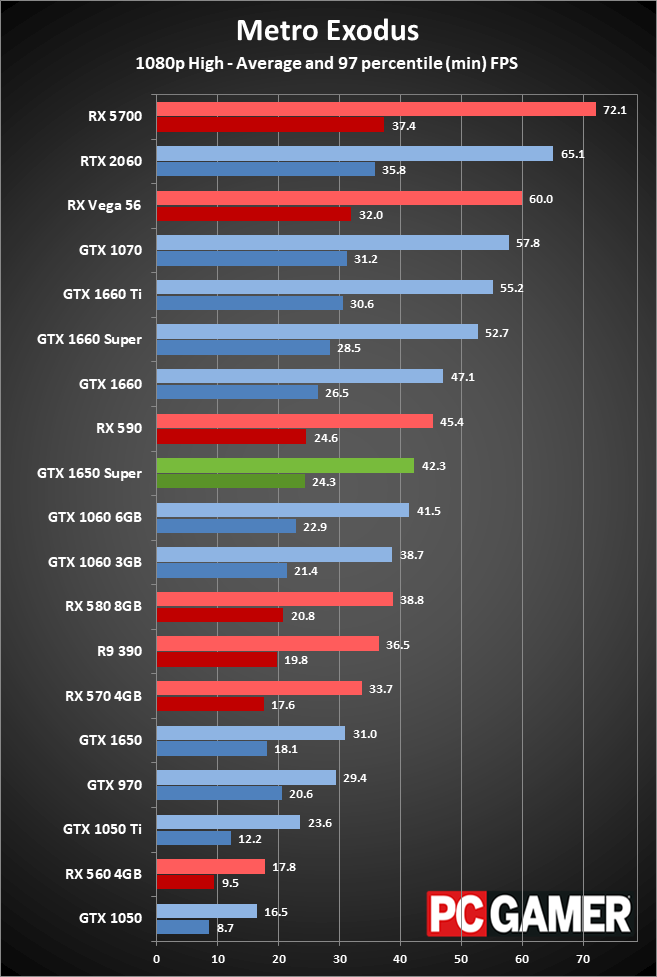
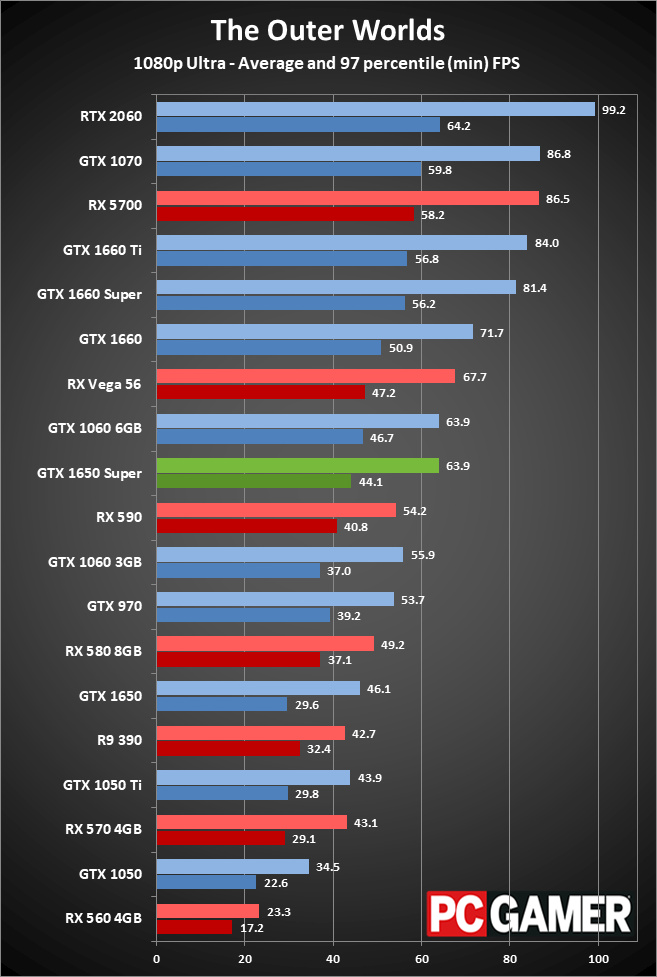
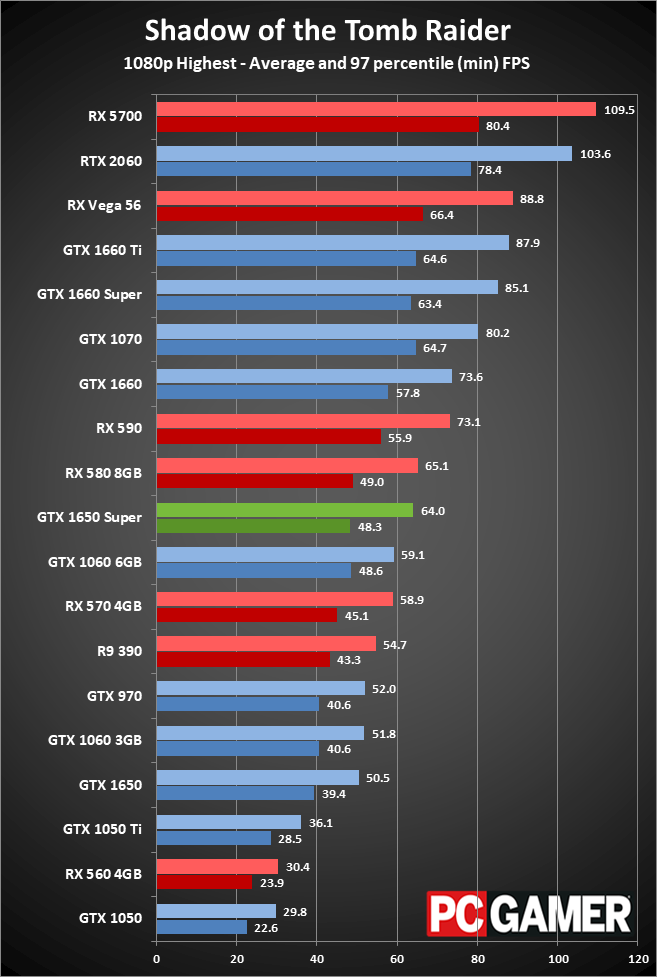
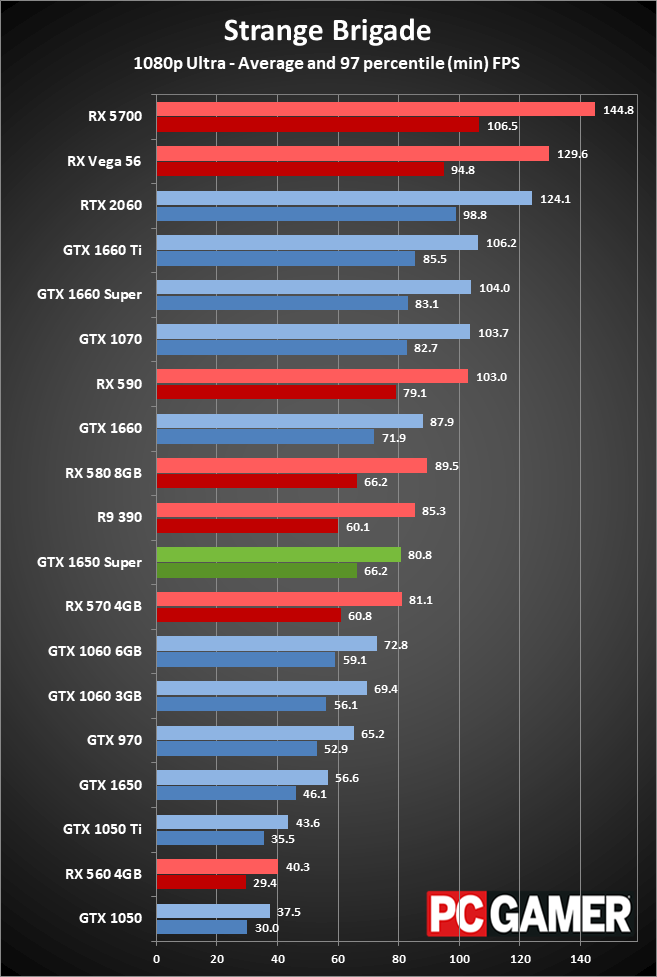
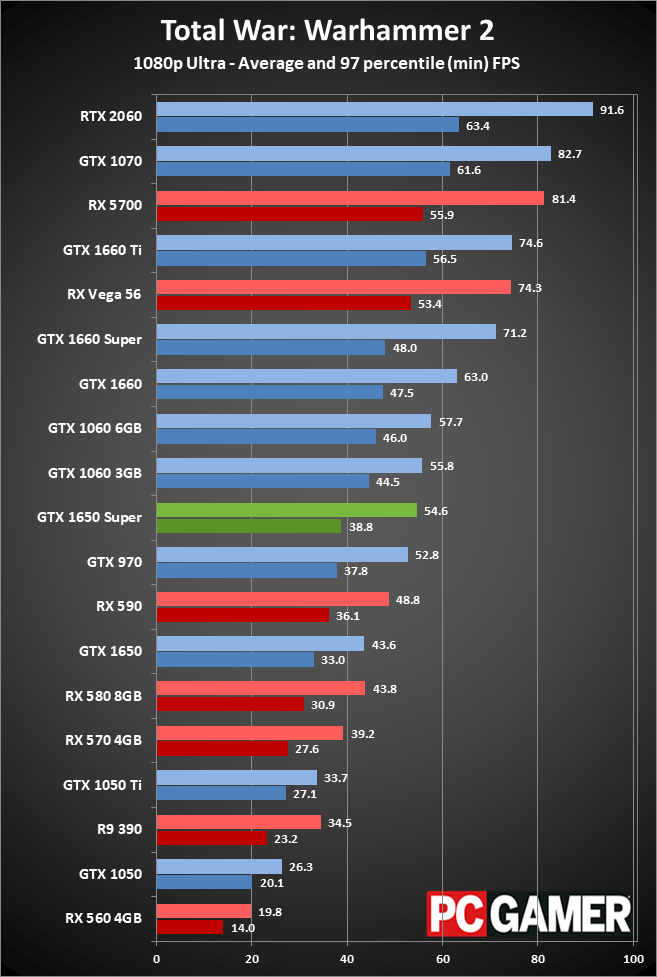
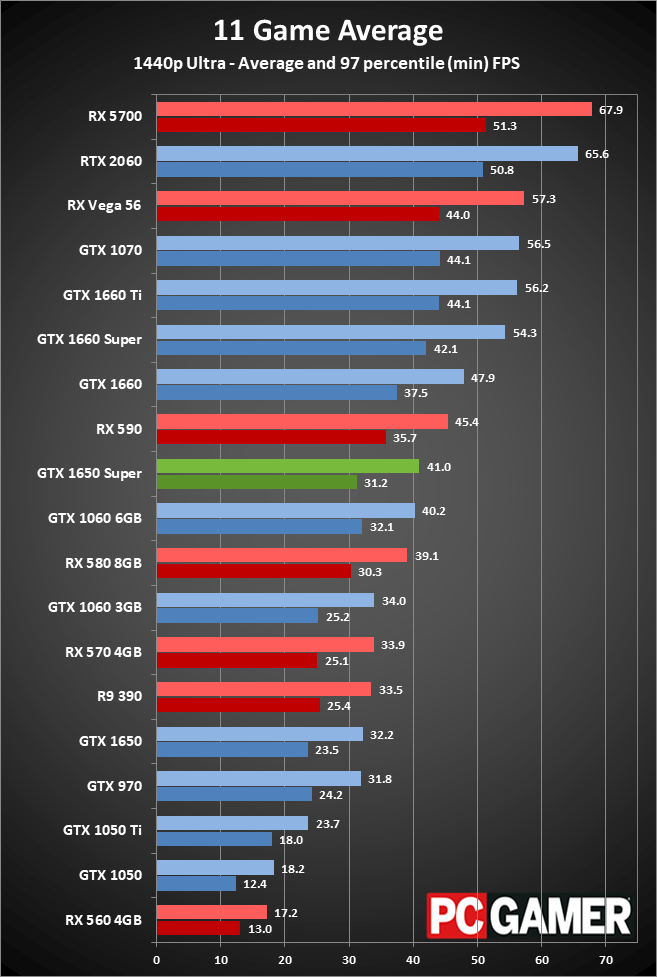
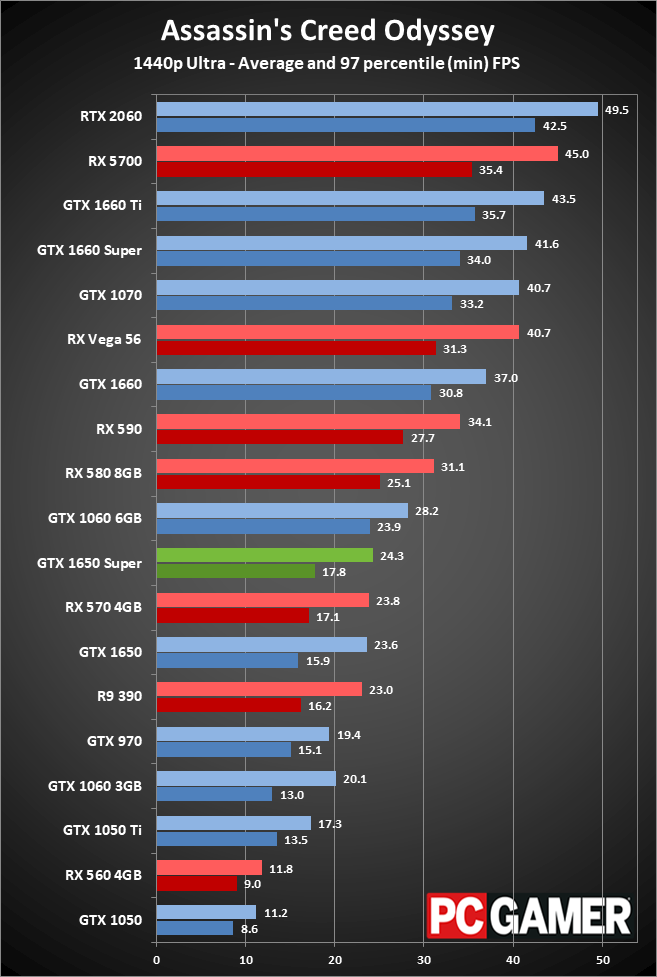
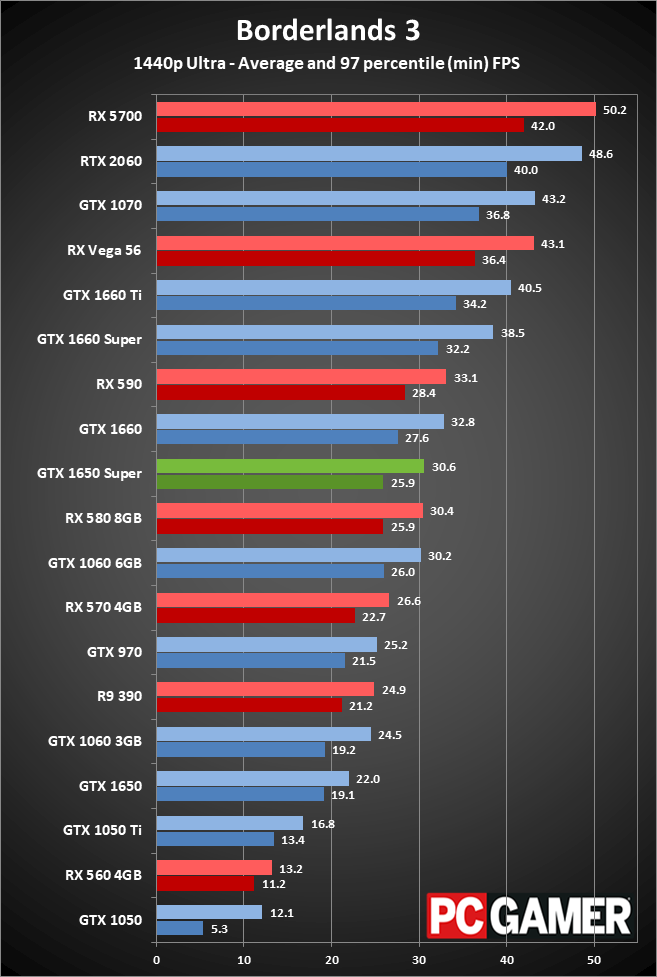
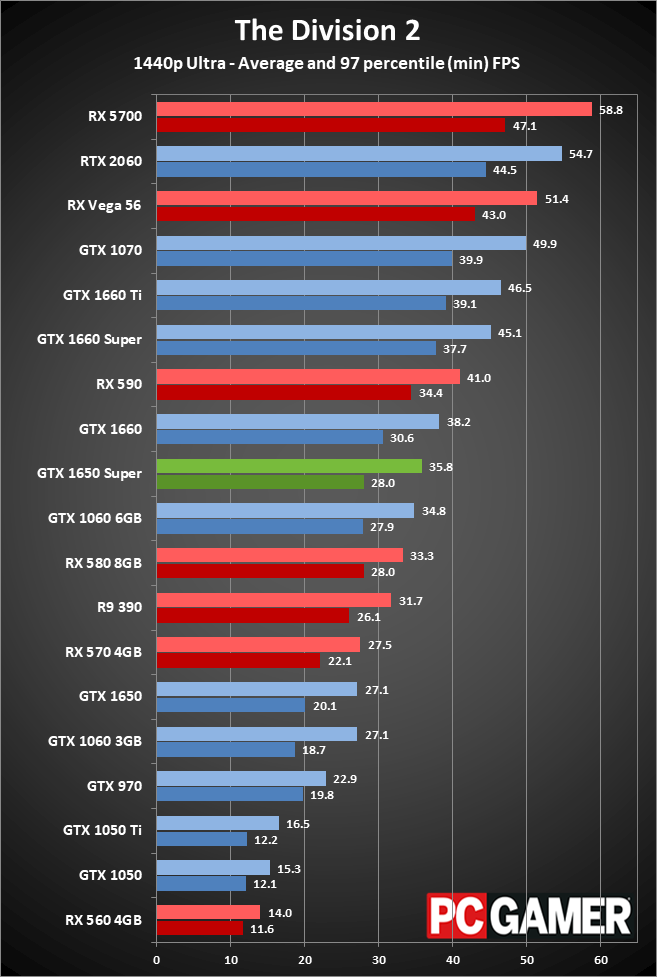
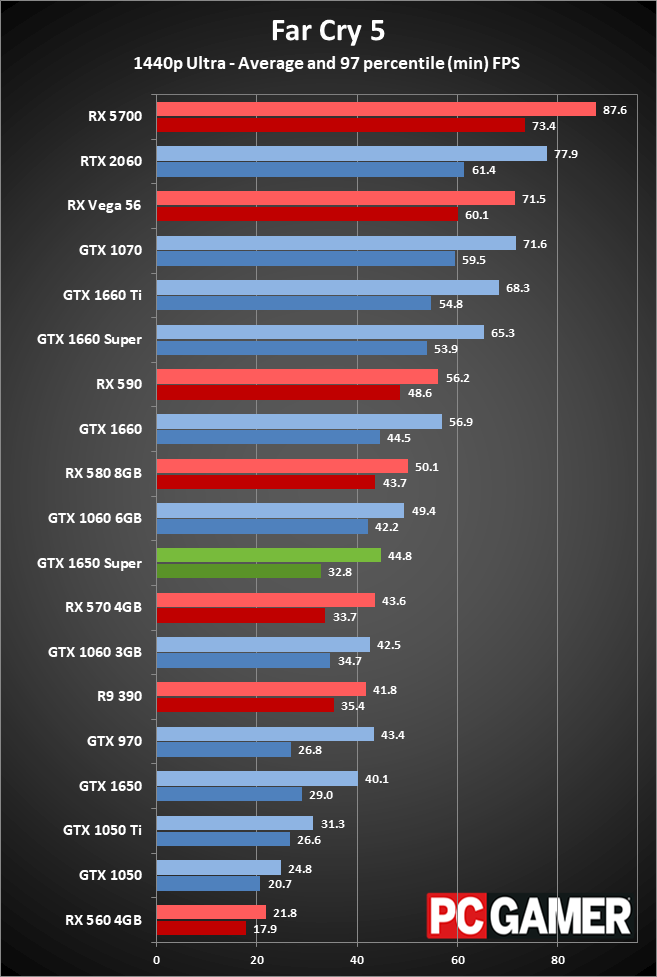
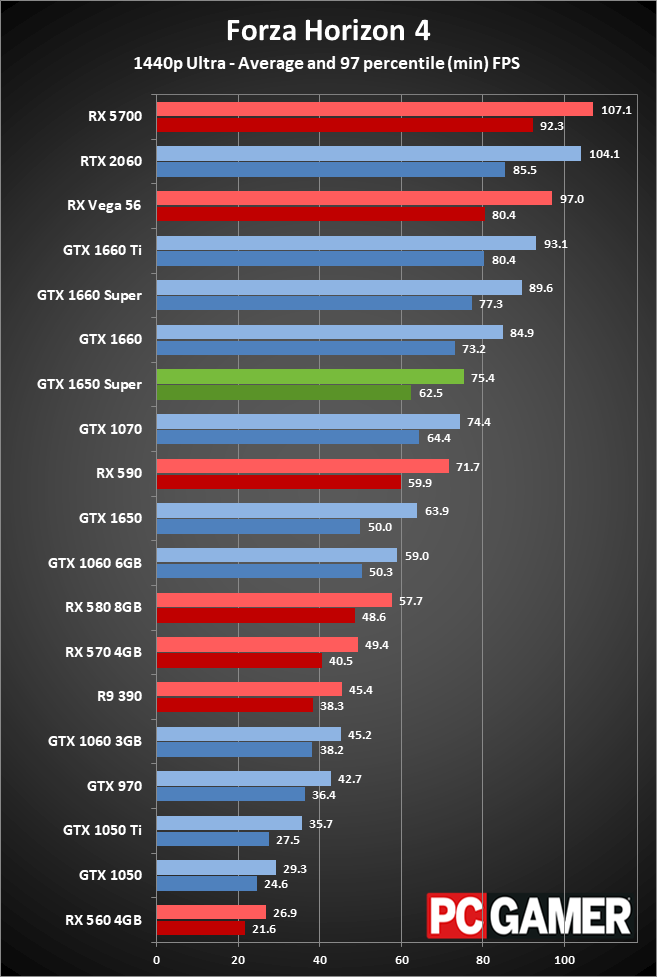
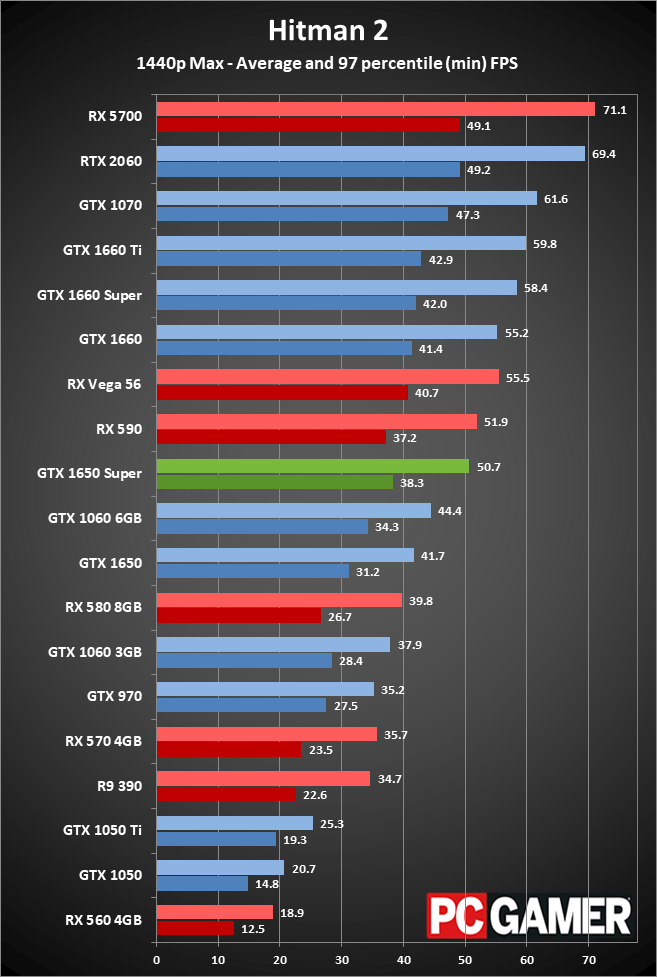
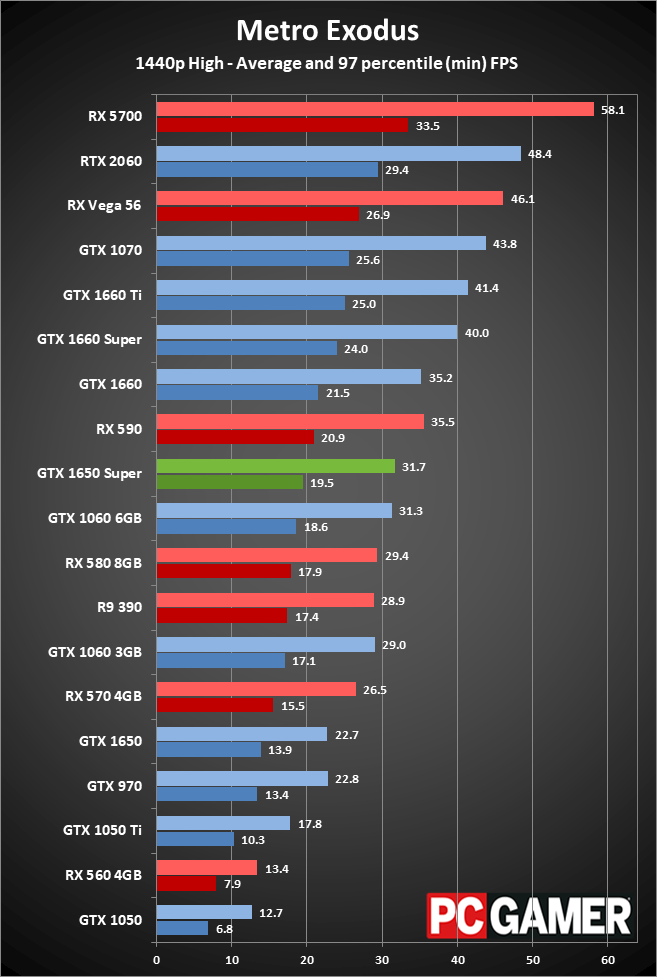
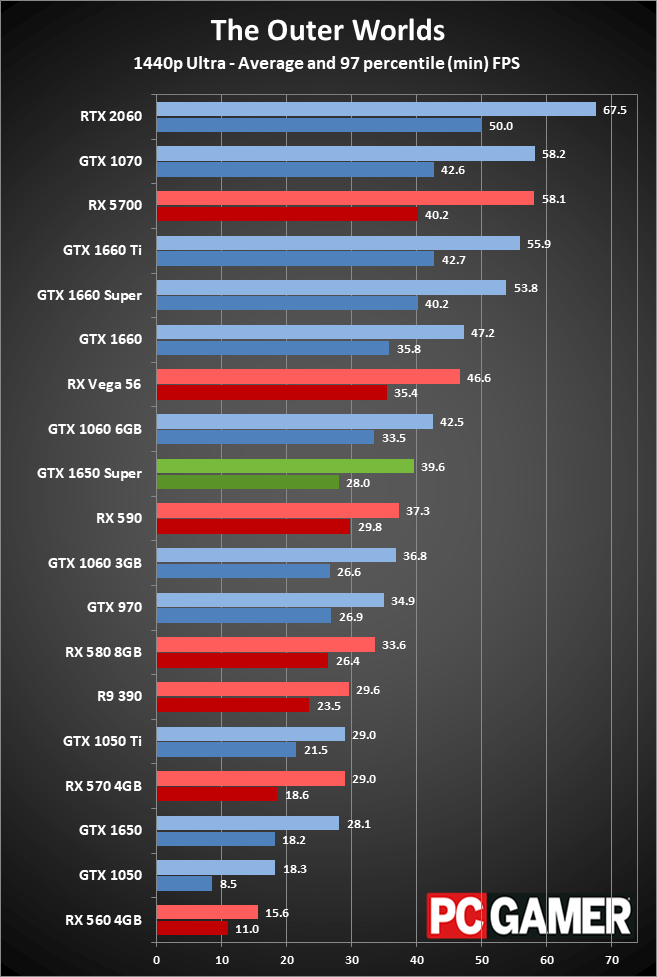
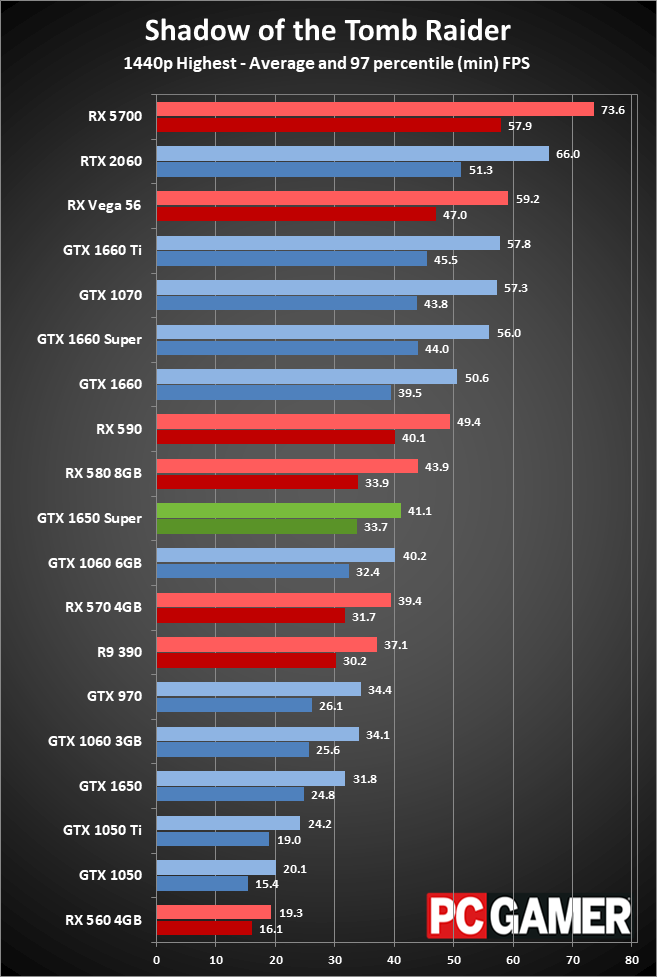
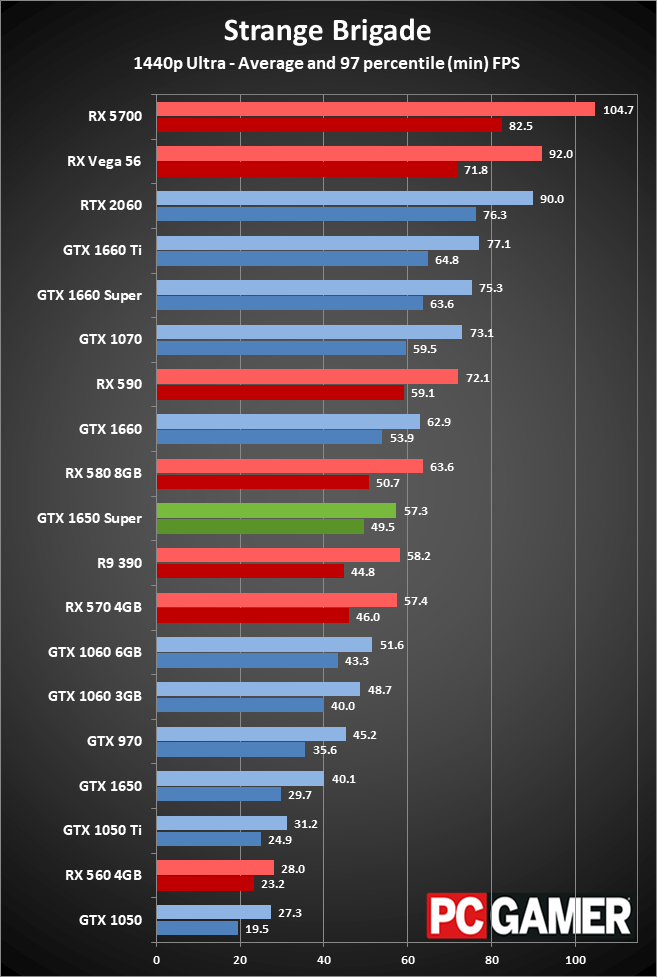
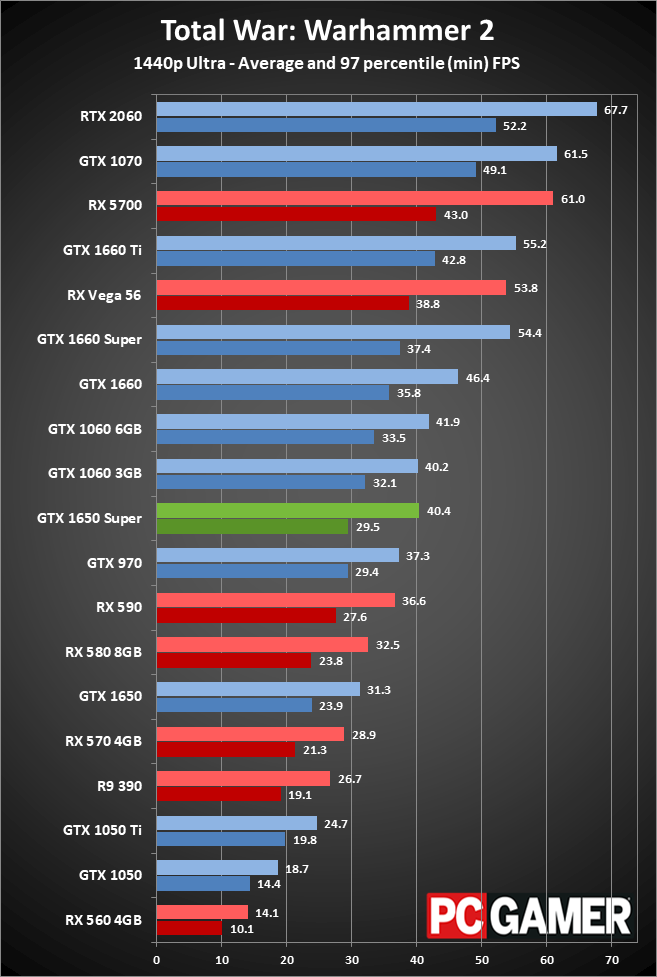
Performance is pretty much what you'd expect. Across all three test settings and resolutions, the 1650 Super is consistently around 30 percent faster than the regular GTX 1650. It's also about 30 percent faster than the old GTX 970, and similarly 30 percent faster than the RX 570 4GB, though the lead drops to 20 percent at 1440p. At 1080p medium, it's nearly as fast as the 1660, but it falls off by 10 percent at 1080p ultra, and 17 percent at 1440p ultra.
The choice of game is of course a factor. Forza Horizon 4, Hitman 2, The Outer Worlds, and Total War: Warhammer 2 tend to favor Nvidia's Turing GPUs more than games like Borderlands 3 and Metro Exodus, while Shadow of the Tomb Raider and Strange Brigade have the 570 and 1650 Super basically tied.
Something else to consider is that the 1650 Super nearly manages to break 60 fps in every game I tested at 1080p medium (Metro Exodus being the sole exception), but at 1080p ultra it's far less of a certain thing. The overall average at 1080p ultra is 61 fps, but only about half of the game break 60 while the other half range from around 40 fps up to 55 fps.
If you're interested in lighter fare like Fortnite, Overwatch, CS:GO, or Rainbow Six: Siege, the 1650 Super will do just fine at 1080p and max quality (or close to it). Games like Assassin's Creed, Metro Exodus, and Borderlands 3 on the other hand will benefit from turning down a few settings.

GeForce GTX 1650 Super: a better budget card
Considering the GTX 1650 Super only costs $10 more than the regular GTX 1650, this is a super easy recommendation. (Sorry.) Budget GPUs aren't the most exciting graphics cards, but for people trying to games without spending a ton of cash, this is a great entry level card that can easily run any current game.
Just don't expect max settings and higher resolutions in every game, and beware of future games that could push beyond the capabilities of the 4GB VRAM. If you can spend the extra $50 to $75, upgrading to a GTX 1660 Super is a better long-term decision.
As for AMD, the RX 5500 retail launch is still a bit of a mystery. I've been expecting cards to arrive this month, but that hasn't happened yet. Prebuilt PCs from OEMs have started shipping with the card, but I have to think AMD is trying to determine where it should price the retail product.
Against the GTX 1650, the RX 5500 specs look pretty good. AMD's own numbers suggest it should be about as fast as an RX 480, which is only a bit slower than an RX 580. Except now Nvidia has the 1650 Super that consistently beats the RX 580 and comes close to the 590 (unless you play at settings where the 4GB VRAM is a problem), priced at $159.
Will AMD low ball the RX 5500 to deliver a better overall value? Or will it shoot for a similar price and end up with potentially lower performance for just a few dollars less? A new budget Navi card could give Nvidia some competition, but right now, the GTX 1650 Super claims the crown for best budget graphics card.
Arguably the best budget GPU right now, though the 4GB VRAM could prove limiting in upcoming games.
Jarred's love of computers dates back to the dark ages when his dad brought home a DOS 2.3 PC and he left his C-64 behind. He eventually built his first custom PC in 1990 with a 286 12MHz, only to discover it was already woefully outdated when Wing Commander was released a few months later. He holds a BS in Computer Science from Brigham Young University and has been working as a tech journalist since 2004, writing for AnandTech, Maximum PC, and PC Gamer. From the first S3 Virge '3D decelerators' to today's GPUs, Jarred keeps up with all the latest graphics trends and is the one to ask about game performance.


